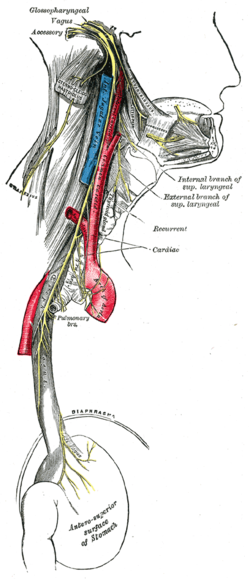Structure and Function of the Vagus Nerve
- Vagus nerve extends through the jugular foramen and passes into the carotid sheath
- Innervates the viscera
- Sensory fibers originate from neurons of the nodose ganglion
- Motor fibers come from neurons of the dorsal motor nucleus of the vagus and the nucleus ambiguus
- Supplies motor parasympathetic fibers to organs
- Controls skeletal muscles in the mouth
- Responsible for heart rate, gastrointestinal peristalsis, and sweating
- Innervates the inner portion of the outer ear and part of the meninges
- Regulates inflammation in the body
Cardiac and Urogenital Effects of the Vagus Nerve
- Parasympathetic innervation of the heart is controlled by the vagus nerve
- Vagal and spinal ganglionic nerves lower the heart rate
- Right vagus branch innervates the sinoatrial node
- Hyperstimulation of parasympathetic influence promotes bradyarrhythmias
- Left vagal branch predisposes the heart to conduction block at the atrioventricular node
- Excessive activation of the vagal nerve during emotional stress can cause vasovagal syncope
- Vasovagal syncope affects young children and women more than other groups
- Can lead to temporary loss of bladder control under extreme fear
- Women with complete spinal cord injury can experience orgasms through the vagus nerve
- Insulin signaling activates ATP-sensitive potassium channels and decreases glucose production by the liver
Clinical Significance of the Vagus Nerve
- Anticholinergic drugs inhibit the action of the vagus nerve on the heart and other organs
- Drugs that inhibit muscarinic receptors increase heart rate and treat bradycardia
- Vasovagal syncope can cause a sudden drop in cardiac output and cerebral hypoperfusion
- Vagus nerve stimulation can be used to treat certain neurological disorders
- Vagus nerve plays a role in the regulation of inflammation and satiation
Stimulation of the Vagus Nerve
- Vagus nerve stimulation (VNS) therapy has been used to control seizures in epilepsy patients and treat drug-resistant clinical depression
- Noninvasive VNS devices that stimulate the vagus nerve are available
- VNS can also be achieved through vagal maneuvers such as holding the breath, dipping the face in cold water, coughing, humming or singing, or tensing the stomach muscles
- Patients with certain illnesses may be trained to perform vagal maneuvers
- Vagus nerve blocking (VBLOC) therapy is similar to VNS but used only during the day and has shown promising results in weight loss
Vagus Nerve Pathology and Other Health Conditions
- Vagotomy, a now obsolete therapy, was performed for peptic ulcer disease but has been superseded by oral medications
- Vagotomy is being researched as a less invasive alternative weight-loss procedure to gastric bypass surgery
- Vagus nerve dysfunction can cause various symptoms throughout the body due to its control over the autonomic nervous system
- Vagus nerve involvement in cluster headaches
- Vagus nerve involvement in Parkinson's disease
- Vagus nerve cough reflex and chronic cough
- Potential role of the vagus nerve in pernicious anemia
The vagus nerve, also known as the tenth cranial nerve, cranial nerve X, or simply CN X, is a cranial nerve that carries sensory fibers that create a pathway that interfaces with the parasympathetic control of the heart, lungs, and digestive tract. It comprises two nerves—the left and right vagus nerves—but they are typically referred to collectively as a single subsystem. The vagus is the longest nerve of the autonomic nervous system in the human body and comprises both sensory and motor fibers. The sensory fibers originate from neurons of the nodose ganglion, whereas the motor fibers come from neurons of the dorsal motor nucleus of the vagus and the nucleus ambiguus. The vagus was also historically called the pneumogastric nerve.
| Vagus nerve | |
|---|---|
 Plan of the upper portions of the glossopharyngeal, vagus, and accessory nerves. | |
 Course and distribution of the glossopharyngeal, vagus, and accessory nerves. | |
| Details | |
| Innervates | Levator veli palatini, Salpingopharyngeus, Palatoglossus, Palatopharyngeus, Superior pharyngeal constrictor, Middle pharyngeal constrictor, Inferior pharyngeal constrictor, viscera |
| Identifiers | |
| Latin | nervus vagus |
| MeSH | D014630 |
| NeuroNames | 702 |
| TA98 | A14.2.01.153 |
| TA2 | 6332 |
| FMA | 5731 |
| Anatomical terms of neuroanatomy | |
Partial translation of New Latin nervus vagus (“wandering nerve”).
vagus nerve (plural vagus nerves)